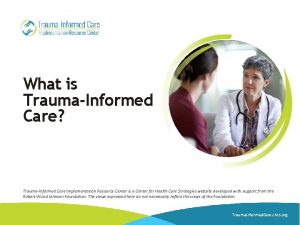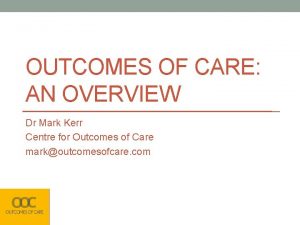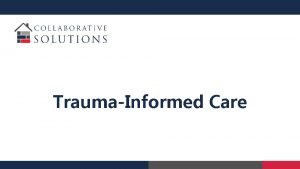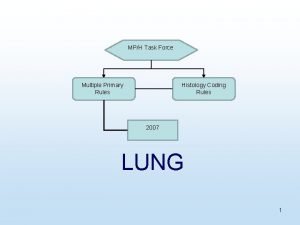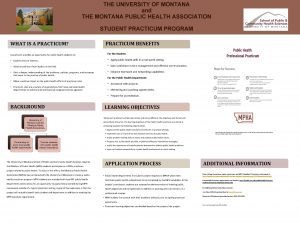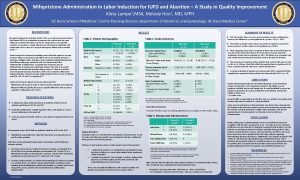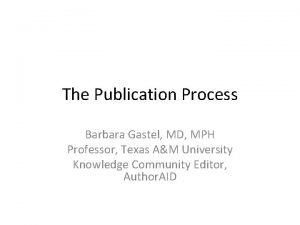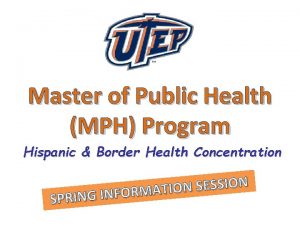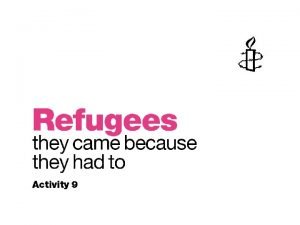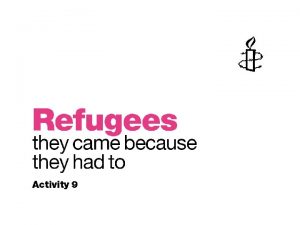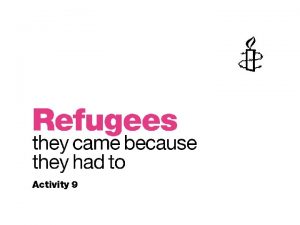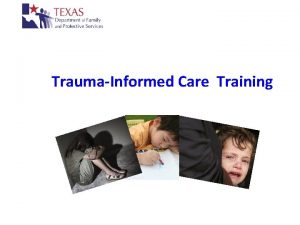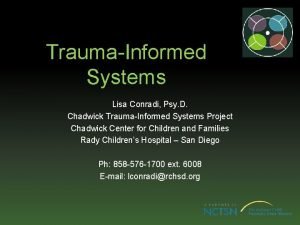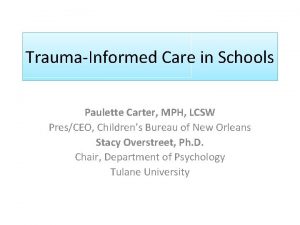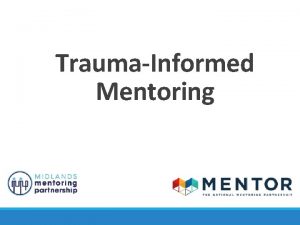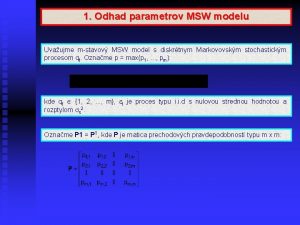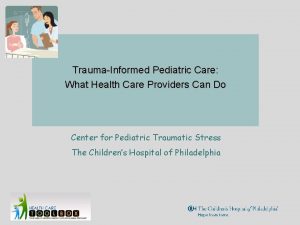TraumaInformed Care Introductions Ashley Kerr MSW MPH Director

































- Slides: 33

Trauma-Informed Care

Introductions Ashley Kerr, MSW MPH Director of Programs ashley@collaborative-solutions. net

What is trauma-informed care? • Trauma-informed Care (TIC) is an organizational structure and treatment framework that involves understanding, recognizing, and responding to the effects of all types of trauma. It emphasizes physical, psychological and emotional safety for both consumers and providers, and helps survivors rebuild a sense of control and empowerment.

Trauma defined • Individual trauma results from an event, series of events, or set of circumstances that is experienced by an individual as physically or emotionally harmful or life threatening and that has lasting adverse effects on the individual’s functioning and mental, physical, social, emotional, or spiritual wellbeing.

Traumatic Events: Basics • A person experiences, witnesses or is confronted with actual or threatened death or serious injury or threat to the physical integrity of oneself or others. • Often includes a response of intense fear, helplessness or horror. • Examples: Rape or sexual assault, fire or natural disaster, robbery or other crime, other physical violence.

Variables Impacting Trauma Severity • Type of event and intensity of exposure • Frequency of trauma (one-time, ongoing) • How it happens (witness, learned about it) • When it happened (child, adult) • Quality of the response • Was disassociation present? • Access to support and resources

Dissociation Defined • It is a disturbance of thinking, awareness, identity, consciousness or memory. • Dissociation is more than just ordinary forgetfulness. • It is not associated with any underlying cause of memory deficits or altered consciousness (e. g. , neurological illnesses, substance or alcohol abuse). • Some people have dissociative events that last only moments where as others experience extended periods of dissociation.

The 3 E’s • Event(s) • Experience of event(s) • Effect

The 4 R’s • Realize • Recognize • Respond • Resist Re-traumatization

Impact of Trauma • Strong and prolonged activation of the body’s stress management systems in the absence of the buffering protection of adult support, disrupts brain architecture and leads to stress management systems that respond at relatively lower thresholds, thereby increasing the risk of stress-related physical and mental illness.

Physiology of Trauma • Recognition of threat stimulates stress-response pathways. Adrenaline and several endocrine hormones are released into the bloodstream. • Repeated acute stress response takes a toll on the body over time. • The individual may not fully return to baseline so may function at a hyper or hypo state of arousal.

Trauma Reactions: “Difficult Behaviors” • There are many common trauma reactions that may explain some “difficult” behaviors or reactions within agency settings. • Example: chronic physical complaints, interpersonal isolation, poor impulse control or easily angered.

Basics for Case Managers • The nature of trauma is complex. • Trauma affects people in different ways. • Trauma recovery is possible but it is challenging.

Trauma-informed Approach • The 6 key principles fundamental to a trauma-informed approach include: • • • Safety Trustworthiness and transparency Peer support Collaboration and mutuality Empowerment, voice, and choice Cultural, historical, and gender issues

Safety • Many trauma-affected clients have a persistent danger orientation • Clients, whether children or adults, should feel physically and psychologically safe in your agency. • The physical setting is safe and interpersonal interactions promote a sense of safety. • What are some ways you can incorporate this principle in your work?

Trustworthiness and transparency • Goal of building and maintaining trust with clients and family members, and among staff is key. • Publicize rights and responsibilities. • Make contracts/agreements honestly. • Acknowledge any inconsistency and validate confusion.

Peer Support • Peer support and mutual self-help are key vehicles for establishing safety and hope, building trust, enhancing collaboration, and utilizing their stories and lived experience to promote recovery and healing. • The term “peer” refers to individuals with lived experiences of trauma, or in the case of children this may be family members of children who have experienced traumatic events and are key caregivers in their recovery.

Collaboration and Mutuality • Creating a level playing field between staff and clients is beneficial in the treatment process. • Power sharing • Mutual decision-making • Rules and regulations in a trauma-informed system. • Allowing grievance, ventilating, validation.

Empowerment, Voice, Choice • Clients are supported in shared decision-making, choice, and goal setting to determine the plan of action they need to heal and move forward. • Services are voluntary. • Clients are supported in cultivating self-advocacy skills. • Staff facilitate recovery rather than controllers of recovery.

Avoiding Re-Traumatization • Anticipate and be sensitive to the needs of clients who have experienced trauma regarding program policies and procedures in the treatment setting that might trigger memories of trauma. • Attend to clients’ experiences. Ignoring clients’ behavioral and emotional reactions to having their traumatic memories triggered is more likely to increase these responses than decrease them.

Avoiding Re-Traumatization • Develop an individual coping plan in anticipation of triggers that the individual is likely to experience in treatment based on his or her history. • Rehearse routinely the coping strategies highlighted in the coping plan. • Recognize that programmatic efforts to control behavior can cause traumatic stress reactions, particularly for trauma survivors for whom being trapped was part of the trauma experience.

Avoiding Re-Traumatization • Respond with consistency. • Listen for the specific trigger that seems to be driving the client’s reaction. • Make sure that staff and other clients do not shame the trauma survivor for his or her behavior, through teasing or joking about the situation.

Defining Triggers • A trigger such as a person, place, or event may unexpectedly remind him/her of the trauma and draw his/her attention back to intense and disturbing memories that overwhelm his/her ability to cope again.

Signs of Distress • Emotional reactions • Anxiety, fear, powerlessness, helplessness, worry, anger • Physical or somatic reactions • Nausea, light headedness, increase in BP, headaches, stomach aches, increase in heart rate and respiration or holding breath • Behavioral reactions • Crying, uncooperative, argumentative, unresponsive, restlessness • Cognitive reactions • Memory impairment or forgetfulness, inability to give adequate history

Guidance on Screening and Assessment • Know your scope of practice. • If screening, use only validated tools. • Avoid screening without adequate capacity for mental health support. • Only conduct assessment if evidence-based trauma treatment can be accessed.

Normalizing Responses • I believe you. • I believe what happened was wrong. There is no excuse for that. • I believe what happened was not your fault. • I believe events like this often cause harm. • Many people experience _______ (name symptom) as you report. • I believe people can get better. • I am willing to help.

Secondary Trauma • Often known as vicarious trauma or compassion fatigue • If not identified and if there are no resources available to support staff, organizations will see burnout and high turnover rates

TIC – Organizational Perspective • What does an organization have to do to implement a traumainformed approach?

TIC – physical location • What does a trauma-informed office look like? • • Attributes Colors Smells Textures

Activity: TIC Planning • Review list of possible re-traumatizing events. • Discuss ways to prevent re-traumatization in your agency. • Identify ‘next steps’ if business practices need to be altered.

Module Three: Key ‘Take-Aways’ • Many consumers bring multiple, complex traumas to the housing encounter. • Providers and facilities need to be very aware of best practices in working with a trauma-impacted population. • There are multiple evidence-based interventions which should be guiding clinical decision-making. • Support for caregivers is sometimes overlooked and is a critical element in a trauma-informed approach.

Questions / Discussion

Contact Information • Ashley Kerr, ashley@collaborative-solutions. net • For more information about Collaborative Solutions, please visit us at www. collaborative-solutions. net
 Traumainformed care
Traumainformed care M.e kerr
M.e kerr Steve kerr madeleine kerr
Steve kerr madeleine kerr Dr ashley kerr
Dr ashley kerr Primary, secondary, tertiary care
Primary, secondary, tertiary care 51g to mph
51g to mph Drexel executive mph
Drexel executive mph Lyme disease
Lyme disease Mph rules
Mph rules Beverly loudin md mph
Beverly loudin md mph Stfm annual spring conference
Stfm annual spring conference University of montana mph
University of montana mph Umass online mph
Umass online mph School of public health monash
School of public health monash 65mph to ft/s
65mph to ft/s Melody hou md mph
Melody hou md mph Wait 1 h
Wait 1 h A&m md mph
A&m md mph F/s to mph
F/s to mph Webste
Webste Utep mph
Utep mph James fraser ucsf
James fraser ucsf Opatus test
Opatus test How fast does light travel
How fast does light travel Thank you for listening
Thank you for listening 451 kts to mph
451 kts to mph Mudr kampe
Mudr kampe Agenda welcome and introductions
Agenda welcome and introductions Meeting agenda welcome and introductions
Meeting agenda welcome and introductions Introductions clip art
Introductions clip art Meeting agenda welcome and introductions
Meeting agenda welcome and introductions Benjamin franklin quote and intro paragraph
Benjamin franklin quote and intro paragraph Agenda welcome and introductions
Agenda welcome and introductions Survey introductions
Survey introductions
